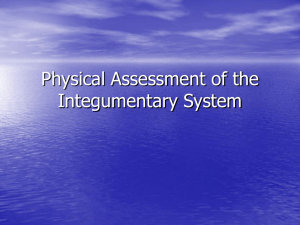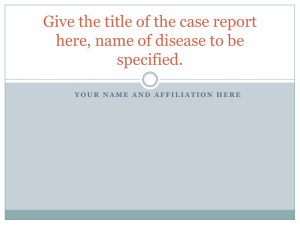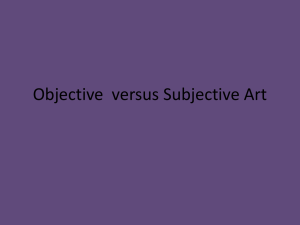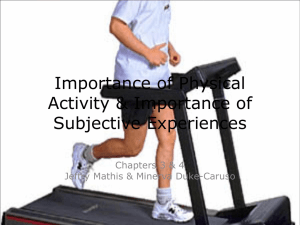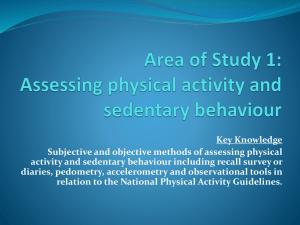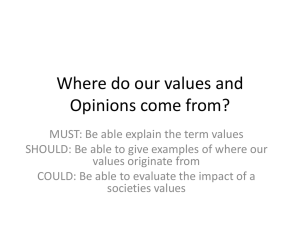physical assessment documentation guide
advertisement
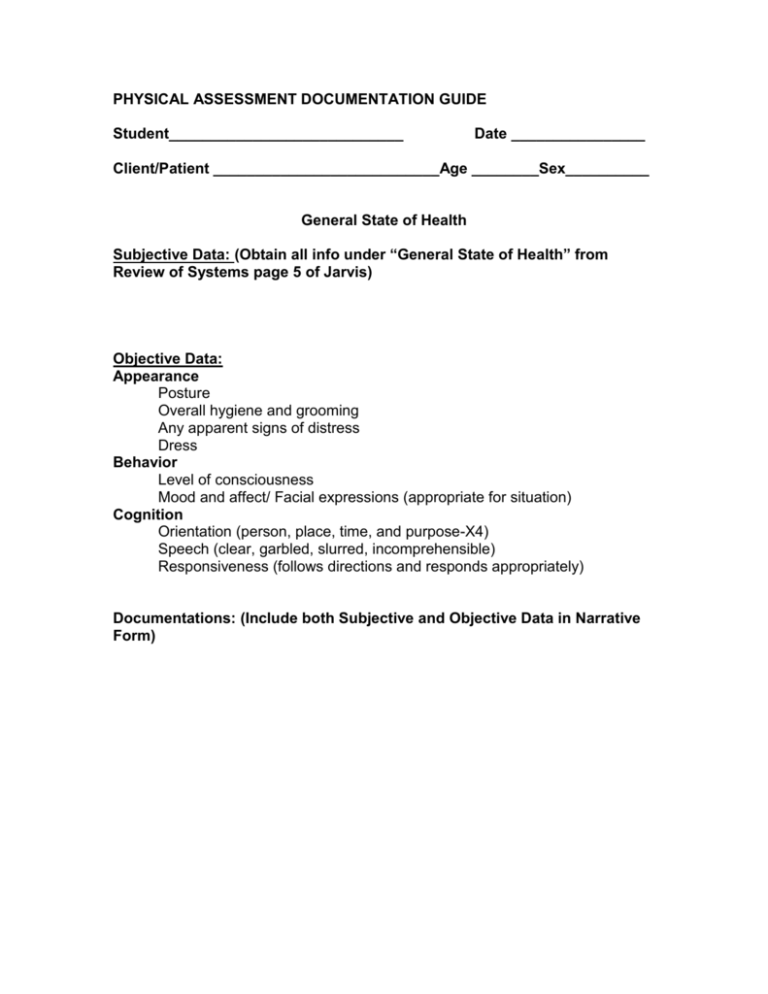
PHYSICAL ASSESSMENT DOCUMENTATION GUIDE Student____________________________ Date ________________ Client/Patient ___________________________Age ________Sex__________ General State of Health Subjective Data: (Obtain all info under “General State of Health” from Review of Systems page 5 of Jarvis) Objective Data: Appearance Posture Overall hygiene and grooming Any apparent signs of distress Dress Behavior Level of consciousness Mood and affect/ Facial expressions (appropriate for situation) Cognition Orientation (person, place, time, and purpose-X4) Speech (clear, garbled, slurred, incomprehensible) Responsiveness (follows directions and responds appropriately) Documentations: (Include both Subjective and Objective Data in Narrative Form) PHYSICAL ASSESSMENT DOCUMENTATION GUIDE Student____________________________ Date ________________ Client/Patient ___________________________Age ________Sex__________ Assessment of the Skin, Hair, and Nails Subjective Data: (Obtain all info under “Skin”, “Hair”, & “Nails” from Review of Systems page 5 Jarvis) Objective Data: Inspection and palpation of the skin Color(pink, cyanotic, jaundiced, erythematous), Pigmentation (even, hyper/hypopigmentation) Lesions (Describe 3) Description – size & color Structure - type of lesion (macule, papule, nodule etc.) Anatomical Distribution Hydration – skin turgor (immediate recoil, tenting) Temperature & Moisture Inspection and palpation of the hair Color & condition Quantity, distribution, & texture Inspection and palpation of the fingernails Color of nail bed Firmness, texture, ridging, irregularities Clubbing: Palpate for firm nail matrix Estimate nail angle Documentation: (Include both Subjective and Objective Data in Narrative Form) PHYSICAL ASSESSMENT DOCUMENTATION GUIDE Student____________________________ Date ________________ Client/Patient ___________________________Age ________Sex__________ Assessment of the Head and Neck Subjective Data: (Obtain all info under “Head, Eyes, Ears, Nose, Mouth and Neck” from Review of Systems page 5-6 Jarvis) Objective Data: Inspection and palpation of the head and face Skull for symmetry & tenderness Face (includes eyes, ears, nose, mouth, and neck) Symmetry Discoloration Lesions Drainage Distention Oral mucous membranes –color, hydration, lesions Documentation: (Include both Subjective and Objective Data in Narrative Form) PHYSICAL ASSESSMENT DOCUMENTATION GUIDE Student____________________________ Date ________________ Client/Patient ___________________________Age ________Sex__________ Assessment of the Chest and Lungs Subjective Data: (Obtain all info under Respiratory from Review of Systems in Jarvis page 6) Objective Data Inspect chest wall Color, Configuration (symmetry) and Lesions Movement Respiratory rate, depth, and effort Auscultate systematically for quality of lung sounds Assessment of lung sounds and location (Clear, diminished, absent) Identify adventitious sounds if present: Wheezes (sibilant or sonorous rhonchi) Crackles (fine or course) Documentation: (Include both Subjective and Objective Data in Narrative Form) PHYSICAL ASSESSMENT DOCUMENTATION GUIDE Student____________________________ Date ________________ Client/Patient ___________________________Age ________Sex__________ Assessment of the Heart and Peripheral Vascular System Subjective Data: (Obtain all info under Cardiovascular, Peripheral Vascular from Review of Systems page 6 Jarvis) Objective Data HEART Inspection Pulsations, lifts, heaves JVD with chest at 35-45 degree angle Auscultation Rhythm assessment of S1 and S2 (Regular/Irregular) Assess all auscultatory sites: APETM Count Apical Heart Rate PERIPHERAL VASCULAR SYSTEM Palpation of Peripheral Pulses Radial Femoral Posterior Tibial Dorsalis Pedis Skin color – extremities (upper and lower) Capillary refill after blanching (secs) Fingers/toes Presence of Edema- depress for 5 seconds (grade if pitting) Documentation: (Include both Subjective and Objective Data in Narrative Form) PHYSICAL ASSESSMENT DOCUMENTATION GUIDE Student____________________________ Date ________________ Client/Patient ___________________________Age ________Sex__________ Assessment of the Abdomen Subjective Data: (Obtain all info under Gastronintestinal, Genitourinary from Review of Systems page 6-7 Jarvis) Objective Data Inspection Contour Lesions Scars Distention Pulsations Hernia (while patient lifts head) Auscultation (all quadrants) Bowel sounds Palpation Light palpation Tension of abdominal wall (soft, firm, hard) Tenderness Masses Deep palpation Tenderness Masses Enlarged organs Percussion CVA tenderness Documentation: (Include both Subjective and Objective Data in Narrative Form) PHYSICAL ASSESSMENT DOCUMENTATION GUIDE Student____________________________ Date ________________ Client/Patient ___________________________Age ________Sex__________ Assessment of the Musculoskeletal System Subjective Data: (Obtain info from Review of Systems under Musculoskeletal in Jarvis) Objective Data Muscle strength Check each muscle group against resistance Compare right with left: Upper extremities Triceps Biceps Adduction arms Abduction arms Wrists – flexion, extension Lower extremities Quadriceps Hamstrings Abduction knees Adduction knees Plantar flexion feet Dorsiflexion feet Documentation: (Include both Subjective and Objective Data in Narrative Form) PHYSICAL ASSESSMENT DOCUMENTATION GUIDE Student____________________________ Date ________________ Client/Patient ___________________________Age ________Sex__________ Neurological Assessment Subjective Data: (Obtain info from Review of Systems under Neurological in Jarvis) Objective Data Mental Status Examination Appearance (posture, body movement, dress appropriate for setting, grooming/hygiene) Behavior (level of consciousness, facial expression, mood and affect) Cognition (orientation x4, responsiveness, speech) Thought Processes (thought content for consistency and logic, perceptions consistency with reality, any suicidal thought) Pupillary Reaction (equality, size, shape, reaction to direct and consensual light) Sensory system Spinothalamic tract Light touch Pain and temperature (only if negative result to light touch) Posterior column tract Vibration Kinesthesia (position sense) Stereognosis Graphesthesia Two-point discrimination Motor function Hand grips Foot pushes Deep tendon reflexes (Grade) Biceps C5-C6 Triceps C7-C8 Brachioradialis C5-C6 Quadriceps L2-L4 Achilles L5-S1 Cerebellar Functions Balance Gait Gross motor coordination – heel to toe walking Romberg Rapid Alternating Movements (RAM) Documentation: (Include both Subjective and Objective Data in Narrative Form) PHYSICAL ASSESSMENT PRACTICUM Student____________________________ Date ________________ **Starred ** items are critical elements and must be passed by the student. Technique (5) General Survey: Appearance (posture, grooming, hygiene, apparent signs of distress, dress) Behavior (attitude, mood and affect, facial expressions) Cognition (mental status, speech, level of orientation) Skin Color (pink, cyanotic, jaundice, dusky, pale) Hydration – skin turgor Temp. and Moisture (warm/cool, dry/clammy) Lesions (describes morphology, size, color, pattern of Arrangement, and distribution) Head and Neck Inspection of skull, face (eyes, ears, nose, mouth, , and neck) Include oral mucous membranes (moist/dry) Assess for drainage, lesions, distention, discoloration, and symmetry Lungs Performs inspection before auscultation Assess respiratory effort and rate Assess for symmetry of chest wall movement (chest expansion symmetrical) Auscultate for breath sounds (anterior or posterior chest) in a systematic order Heart Identify auscultatory sites: Aortic – 2nd right ICS Pulmonic – 2nd left ICS Tricuspic – Left 5th ICS sternal border or midsternal line Mitral – left 5th ICS midclavicular line **Auscultate S1 and S2 - assess rhythm (S1 S2 Reg./irreg.) assess for extra heart sounds & murmurs Identify PMI (left 5th ICS midclavicular line) Count Apical heart rate (BPM) Organization (5) Clear Instructions(2) Description Accurate (4) Technique (5) Organization (5) Clear Instruction (2) /45 /18 Description Accurate (4) Peripheral Vascular Palpates for pulses together: Radial, Femoral, Posterior tibial, Pedal Capillary refill (secs) **Assess for edema (depresses medial malleolus or pretibial area for 5 seconds) Abdomen Inspect for contour,lesions,distention Ausculate all 4 quadrants for bowel sounds Light palpation all quadrants (bend knees before palpation) ** (begins at RLQ and proceeds clockwise) Musculoskeletal ROM and Motor strength against resistance: Upper extremities (arms only – biceps, triceps) Lower extremities (legs only – quadriceps) Functional Assessment Assess pt’s ability to get up out of chair or bed (with or without Assistance: minimal or maximal assist) Neurological Pupils - equal, round, reactive to direct and consensual light Motor - Assess hand grips and foot pushes bilaterally **Sensory – light touch (use cotton ball to forehead, cheek, chin, upper extremities, and lower extremities) **Balance – Romberg Test (assesses for swaying within 20 seconds). **Critical Element: stands behind or beside patient in case patient falls. Gait – normal gait (steady/unsteady/shuffled) TOTAL SCORE: _____/144 /45 /36 COMMENTS: CRITICAL ELEMENTS (** STARRED ITEMS) __________SATISFACTORY __________UNSATISFACTORY (STUDENT MUST TAKE NRSG 251-ADULT P.A.)



